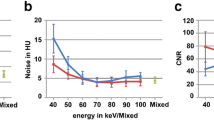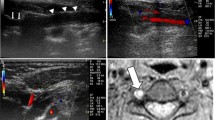Abstract
Purpose
Gadobutrol (GB) is reported to provide improved relaxivity and concentration compared to gadoterate (GT). This study was designed to intraindividually compare quantitative and qualitative enhancement characteristics of GB to GT in cervicocranial magnetic resonance angiography (MRA) of patients with cerebrovascular disease (CVD).
Methods
Patients (n = 54) with CVD underwent two identical contrast-enhanced magnetic resonance angiography (CE-MRA) examinations of the cervical and intracranial vasculature in randomized order, using GB and GT in equimolar dose. Signal-to-noise ratios (SNR) and contrast-to-noise ratios (CNR) were obtained by two independent neuroradiologists, blinded to the applied contrast agents. Qualitative assessment was performed using a three-point scale with a focus on M1/M2 segments.
Results
One thousand and twenty-six vessel segments were analyzed. GB revealed a significantly higher SNR (p = 0.032) and CNR (p = 0.031) in all vessel segments. GB featured a significantly higher SNR and CNR in thoracic (p = 0.022; p = 0.016) and cervical vessels (p = 0.03; p = 0.038), as well as in the posterior circulation (p = 0.012; p = 0.005). In blinded qualitative assessment, overall preference was given to GB (p = 0.02), showing a significant better delineation of the M1/M2 segments (p = 0.041).
Conclusion
Compared to GT, the use of GB results in a significantly higher SNR and CNR in cervical and cerebral CE-MRA, leading to a better delineation of the intracranial vasculature. Present results underline the potential of GB for improved CE-MRA assessment of vasculature in CVD patients.






Similar content being viewed by others
References
Donnan GA, Fisher M, Macleod M, Davis SM (2008) Stroke. Lancet 371(9624):1612–1623
UK-I JM, Young V, Gillard JH (2009) Carotid-artery imaging in the diagnosis and management of patients at risk of stroke. Lancet Neurol 8(6):569–580
Fairhead JF, Mehta Z, Rothwell PM (2005) Population-based study of delays in carotid imaging and surgery and the risk of recurrent stroke. Neurology 65(3):371–375
Herborn CU, Lauenstein TC, Ruehm SG, Bosk S, Debatin JF, Goyen M (2003) Intraindividual comparison of gadopentetate dimeglumine, gadobenate dimeglumine, and gadobutrol for pelvic 3D magnetic resonance angiography. Investig Radiol 38(1):27–33
Goyen M, Herborn CU, Vogt FM et al (2003) Using a 1 M Gd-chelate (gadobutrol) for total-body three-dimensional MR angiography: preliminary experience. J Magn Reson Imaging: JMRI 17(5):565–571
Degnan AJ, Gallagher G, Teng Z, Lu J, Liu Q, Gillard JH (2012) MR angiography and imaging for the evaluation of middle cerebral artery atherosclerotic disease. AJNR Am J Neuroradiol 33(8):1427–1435
Giesel FL, Mehndiratta A, Essig M (2010) High-relaxivity contrast-enhanced magnetic resonance neuroimaging: a review. Eur Radiol 20(10):2461–2474
Altun E, Semelka RC, Cakit C (2009) Nephrogenic systemic fibrosis and management of high-risk patients. Acad Radiol 16(7):897–905
Shen Y, Goerner FL, Snyder C et al (2015) T1 relaxivities of gadolinium-based magnetic resonance contrast agents in human whole blood at 1.5, 3, and 7 T. Investig Radiol 50(5):330–338
Tombach B, Heindel W (2002) Value of 1.0- M gadolinium chelates: review of preclinical and clinical data on gadobutrol. Eur Radiol 12(6):1550–1556
Scott LJ (2013) Gadobutrol: a review of its use for contrast-enhanced magnetic resonance imaging in adults and children. Clin Drug Investig 33(4):303–314
Kramer H, Runge VM, Naul LG, Loynachan AT, Reiser MF, Wintersperger BJ (2010) Brain MRI with single-dose (0.1 mmol/kg) Gadobutrol at 1.5 T and 3 T: comparison with 0.15 mmol/kg gadoterate meglumine. AJR. Am J Roentgenol 194(5):1337–1342
Saake M, Langner S, Schwenke C et al (2016) MRI in multiple sclerosis: an intra-individual, randomized and multicentric comparison of gadobutrol with gadoterate meglumine at 3 T. Eur Radiol 26(3):820–828
Haneder S, Attenberger UI, Schoenberg SO, Loewe C, Arnaiz J, Michaely HJ (2012) Comparison of 0.5 M gadoterate and 1.0 M gadobutrol in peripheral MRA: a prospective, single-center, randomized, crossover, double-blind study. J Magn Reson Imaging: JMRI 36(5):1213–1221
Pennekamp W, Roggenland D, Hering S et al (2011) Intra-individual, randomised comparison of the MRI contrast agents gadobutrol and gadoterate in imaging the distal lower limb of patients with known or suspected osteomyelitis, evaluated in an off-site blinded read. Eur Radiol 21(5):1058–1067
Kramer JH, Arnoldi E, Francois CJ et al (2013) Dynamic and static magnetic resonance angiography of the supra-aortic vessels at 3.0 T: intraindividual comparison of gadobutrol, gadobenate dimeglumine, and gadoterate meglumine at equimolar dose. Investig Radiol 48(3):121–128
Jauch EC, Saver JL, Adams HP Jr et al (2013) Guidelines for the early management of patients with acute ischemic stroke: a guideline for healthcare professionals from the American Heart Association/American Stroke Association. Stroke 44(3):870–947
Townsend TC, Saloner D, Pan XM, Rapp JH (2003) Contrast material-enhanced MRA overestimates severity of carotid stenosis, compared with 3D time-of-flight MRA. J Vasc Surg 38(1):36–40
Achterberg S, Cramer MJ, Kappelle LJ et al (2010) Patients with coronary, cerebrovascular or peripheral arterial obstructive disease differ in risk for new vascular events and mortality: the SMART study. Eur J Cardiovasc Preven Rehab 17(4):424–430
Attenberger UI, Runge VM, Morelli JN, Williams J, Jackson CB, Michaely HJ (2010) Evaluation of gadobutrol, a macrocyclic, nonionic gadolinium chelate in a brain glioma model: comparison with gadoterate meglumine and gadopentetate dimeglumine at 1.5 T, combined with an assessment of field strength dependence, specifically 1.5 versus 3 T. J Magn Reson Imaging: JMRI 31(3):549–555
Szucs-Farkas Z, Froehlich JM, Ulrich M et al (2008) 1.0-M gadobutrol versus 0.5-M gadoterate for peripheral magnetic resonance angiography: a prospective randomized controlled clinical trial. J Magn Reson Imaging: JMRI 27(6):1399–1405
Fink C, Bock M, Kiessling F et al (2004) Time-resolved contrast-enhanced three-dimensional pulmonary MR-angiography: 1.0 M gadobutrol vs. 0.5 M gadopentetate dimeglumine. J Magn Reson Imaging: JMRI 19(2):202–208
Gutberlet M, Spors B, Grothoff M et al (2004) Comparison of different cardiac MRI sequences at 1.5 T/3.0 T with respect to signal-to-noise and contrast-to-noise ratios—initial experience. RoFo: Fortschritte auf dem Gebiete der Rontgenstrahlen und der Nuklearmedizin 176(6):801–808
Wen H, Denison TJ, Singerman RW, Balaban RS (1997) The intrinsic signal-to-noise ratio in human cardiac imaging at 1.5, 3, and 4 T. J Magn Reson 125(1):65–71
Author information
Authors and Affiliations
Corresponding author
Ethics declarations
Funding
This study was funded by Bayer Healthcare.
Conflict of interest
The authors declare that they have no conflict of interest.
Ethical approval
All procedures performed in studies involving human participants were in accordance with the ethical standards of the institutional and/or national research committee and with the 1964 Helsinki declaration and its later amendments or comparable ethical standards.
Informed consent
Informed consent was obtained from all individual participants included in the study.
Rights and permissions
About this article
Cite this article
Hoelter, P., Lang, S., Weibart, M. et al. Prospective intraindividual comparison of gadoterate and gadobutrol for cervical and intracranial contrast-enhanced magnetic resonance angiography. Neuroradiology 59, 1233–1239 (2017). https://doi.org/10.1007/s00234-017-1922-z
Received:
Accepted:
Published:
Issue Date:
DOI: https://doi.org/10.1007/s00234-017-1922-z




